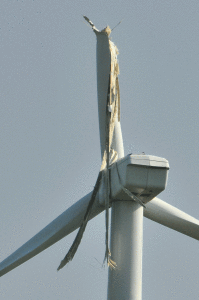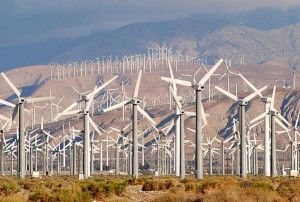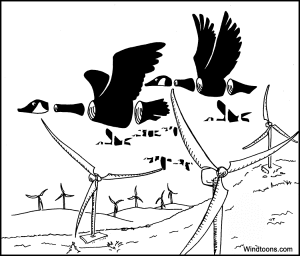 By Christine Morabito – August 2015
By Christine Morabito – August 2015
It is difficult to believe that a project which will permanently alter the environment, kill thousands of birds and bats, threaten marine life, trample the religious freedom of Native Americans, destroy the livelihood of fishermen and those in the tourist industry, risk oil spills, jeopardize public safety and public health, all while significantly increasing the cost of energy, is still being considered. Despite a decade-long battle, public outrage and numerous lawsuits, Cape Wind developers continue to hold a long-term lease to part of Nantucket Sound, and they are not going away.
Our federal and state governments, in their infinite wisdom, have created a gluttonous green monster through generous grants, subsidies, tax breaks, loan guarantees and relaxed regulatory rules for producers of alternative energy. Wind developers and investors know they have been dealt a royal flush, and they are not about to leave all that money on the table.
Massachusetts saw similar crony environmentalism with the now bankrupt Evergreen Solar. Former inspector general, Gregory Sullivan, told Fox News: “The state sunk about $31 million into this company…. The company shortly thereafter went under, 800 people lost their jobs and the business went to China.”
So, when Cape Wind goes bankrupt, which experts are already predicting, taxpayers will lose again. The first red flag – the General Electric’s 3.6 MW turbines planned for the project; the hardware that served as the basis for the extensive environmental impact study, have long since been discontinued for failure to withstand the harsh marine climate. They were to be replaced with Siemens turbines, used in wind projects in Germany and Sweden. Not surprisingly, the technology has been plagued by faulty parts and system failures.
The late Ted Kennedy addressed the U.S. Senate in 2006 regarding Cape Wind and the sweetheart deal made at taxpayer expense:
- “The fact is that the developer, Energy Management Incorporated (EMI) will be eligible for more than $28 million in federal wind energy tax credits in its first year. That’s more than the entire amount they claim to have invested so far.
- They’ll be eligible for those same credits for each of the first ten years of the project’s operation — for a total of $280 million in federal taxpayer subsidies.
- The project will also be eligible for between $37 million and $82 million in renewable energy electricity price support subsidies each year from the ratepayers through Massachusetts renewable energy certificate trading program.
- In addition, this massive project will be eligible for 5-year accelerated depreciation, which means the developer can write off the cost of this $900+ million project on their federal taxes in just five years, even though the project may be in use for at least 20 years.”
Senator Kennedy and others were troubled by the fact that Cape Wind was never properly vetted. From a national security standpoint, they were right to be concerned. Cape Wind had planned to use Bank of Tokyo-Mitsubishi UFJ to arrange debt financing. This was the same bank that, in 2013, was fined $250 million for routing tainted money through the United States from Iran and other countries blacklisted from doing business here.
Shady money has followed wind around the globe. Loose regulations allow them to launder money with ease. A thorough background check would have revealed a link between Cape Wind and organized crime in Italy, which resulted in what the Hawaii Free Press called, “the largest ever asset seizure by anti-Mafia police.” The scandal was exposed by Certified Financial Crime and Anti-Money Laundering Specialist, Christine Duhaime, in her piece: “The Windfather.”
The dark side of wind is conveniently and consistently ignored. Supporters much prefer to embrace the naïve and fantastical idea of ridding the world of fossil fuels.
From the beginning, the true cost of wind energy has been hidden from the public; the benefits and effect on C0₂ emissions have been grossly overstated. While still in the proposal phase, the Cape Wind Draft Environmental Impact Statement (DEIS) was extensively studied by the Beacon Hill Institute, who offered the following:
1. The costs outweigh the benefits by between $83 million and $333 million.
2.The conclusion of “no adverse impacts to tourism and recreation” is not supported by the data.
3. The conclusion that the project would not adversely affect property values is based on a flawed study, ignores other research, and is untenable.
4. The estimates of the value of health improvements are greatly exaggerated.
Cape Wind’s greed and graft was welcomed by opportunistic politicians. Shortly after his administration approved a hefty rate increase, former Massachusetts Governor, Deval Patrick, accepted sizeable donations from National Grid lobbyists, employees and their spouses. Patrick had previously supported a deal between National Grid and Cape Wind, wherein the utility would purchase 50 percent of Cape Wind’s overpriced power (4 times that of traditional sources). National Grid later cancelled the contract when Cape Wind failed to secure financing. However, our energy rates never went down and remain among the highest in the country.
Thanks to the Patrick administration, Massachusetts now has an unrealistically aggressive Renewable Energy Portfolio Standard, (RPS) which requires that a certain percentage of the state’s electricity come from renewable energy.
Many former members of Patrick’s Executive Office of Energy and Environmental Affairs ironically work for the very industry they once regulated. First, they restructured the energy market, requiring citizens to purchase a costly product, (in this case, wind) and now they profit from the sale of said product. See how that works?
Ian Bowles, Patrick’s Secretary of Energy and Environment, joined with former undersecretary, Phil Giudice, and Vivek Mohta, and Bob Keough, two other high ranking energy officials, to start Rhumb Energy. Deerin Babb-Brott, another former energy executive, was made Director of regulatory affairs at Epsilon Associates, specializing in off-shore energy projects.
The problem with crony environmentalism was perhaps best articulated by Barbara Durkin, Cape Wind opponent and litigant, in her September 2014 letter to the Bureau of Ocean Energy Resource Management (BOEM): “Public Interest is undermined when oil, gas, minerals mining, and wind-industry executives partner with government. Inherent is the motivation to serve the interest of industry to monetize, privatize and commoditize public resources, the commons …. Motivation exists to misconstrue the facts, and to manipulate the science in order to divest the public of our precious and critical resources, monetary and natural, when public grants, loan guarantees, public subsidies, and tax credits alone fuel the offshore wind industry.”
Surely we had people in government looking out for our best interests, right? Excellent question. Before its energy costs could even be determined, former Massachusetts Attorney General (AG), Martha Coakley, in what can only be described as a dereliction of duty, strongly supported and publicly endorsed Cape Wind. As AG, it was her job to be an advocate for ratepayers. Instead, Coakley was complicit in falsely presenting the price of wind energy to people of Massachusetts.
Coakley’s idealistic zeal for wind was most vocal when she was a candidate for Ted Kennedy’s Senate seat. She did not hesitate to blame Kennedy’s opposition to the project on the “Not in My Backyard” (NIMBY) syndrome, which was unfair and inaccurate. She also appealed to the hysterical climate alarmists, saying, “We are running out of time to look at what we need to do for alternative energies.”
As discussed in Part 2 of this series, I am perplexed by the ever-growing group of environmental organizations who, ignoring the disturbing environmental impacts, have fallen for the charms of smooth-talking wind developers. In the case of Massachusetts Audubon Society, their unwavering adoration for wind comes with the promise of a substantial monetary reward. Several of Sierra Club’s board members stand to profit if green technology does well. Or, perhaps there is another explanation. My friend Perch has a theory – that these and other well-meaning groups have been “bodysnatched.”
The above column is the final in a 4 part series. Read Part 1, Part 2, Part 3
Related Articles:
Wind Farms Even More Expensive And Pointless Than You Thought
Sierra Club puts almighty dollar ahead of Mother Earth
RSPB makes a killing… from windfarm giants behind turbines accused of destroying rare birds
Critics call politics force behind Cape Wind
Sweden: Offshore Wind Turbines to be Decommissioned After Only 13 Years “Cheapest Option”
Taxpayers—Hide Your Wallets, the DOE is Giving Out Loan Guarantees
